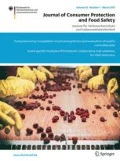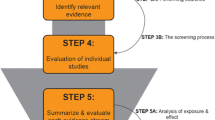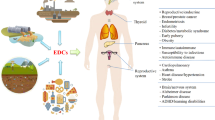Abstract
Recent EU legislation for chemical substances requires a particular assessment of endocrine disrupting properties that may cause adverse effects in humans. Especially for pesticidal active substances, measures concerning specific scientific criteria for the determination of endocrine disrupting properties should have been presented by the European Commission until December 2013. But presently, no specific science-based approach for the assessment of these substances has been agreed upon. This paper is discussing common scientific principles for the evaluation and grouping of substances with endocrine disrupting properties that may cause adverse effects in humans. A matrix-based approach is proposed to be applied in various fields of scientific evaluation of chemical substances, which is based on a scientific evaluation of all available data that may contribute to ensure a high level of protection of human health. This evaluation is expected to be proportionate, consistent and predictable to support administrative decisions in regulatory toxicology. However, a scientifically based categorisation in a decision matrix as a backbone for specific and legally binding rules should be performed according to the relevant EU regulations for the aforementioned groups of substances. Considering the complexity of the matter, it appears appropriate to base possible categorisation on considerations in a decision matrix, which take into account severity, reversibility, potency and consistency of an adverse effect. Based on this decision matrix it should be possible to allocate substances falling under the WHO/IPCS definition to categorise as endocrine disruptors (EDs) or even dispense such substances from categorisation.
Similar content being viewed by others
1 Introduction
Recent EU legislation requires a particular assessment of endocrine disrupting properties that may cause adverse effects in humans for most of the chemical substances. Especially for the approval of active substances in plant protection products [Reg. (EC) No 1107/2009] and biocidal products [Reg. (EU) No 528/2012] a number of new exclusion criteria was introduced. Measures concerning specific scientific criteria for the determination of endocrine disrupting properties should have been presented by the European Commission until December 2013. Such criteria are essentially needed for approval decisions on active substances in plant protection products and biocidal products. But presently, no specific science-based criteria for the assessment of substances with endocrine disrupting properties have been agreed upon. Within both regulations, the EU Commission is required to present a draft of measures concerning specific scientific criteria for the determination of endocrine disrupting properties as soon as possible.
Recently, different sets of criteria have been discussed, addressing the challenges mentioned above (Marx-Stoelting et al. 2011). Governmental agencies such as the Danish EPA (Danish Ministry of the Environment 2011), French ANSES (2012), British CRD/German BfR (BfR and CRD 2011) and non-governmental organisations like ECETOC (2009; Bars et al. 2011) or Chemtrust (2011) have made proposals available on their websites. A number of these proposals have been summarised in a recent EU report (Kortenkamp et al. 2011). Scientific issues on the identification and characterisation of endocrine disruptors have also been discussed by expert panels at the European level and results of these discussions have been summarised in recent reports (EFSA Scientific Committee 2013; OECD Endocrine Disrupters Expert Advisory Group 2013). While most of the approaches discussed have some principles in common regarding hazard identification, they also show differences especially when it comes to proposals for decision making concerning the regulatory exclusion. Most proposals are based on the WHO/IPCS definition for an endocrine disruptor as “…an exogenous substance or mixture that alters function(s) of the endocrine system and consequently causes adverse health effects in an intact organism, or its progeny, or (sub)populations” (WHO/IPCS 2002). As such they concentrate on adverse effects caused by a substance, taking into account the mode or mechanism of action which has to be related to endocrine disruption. In addition, most decision strategies propose to use a weight of evidence approach and to consider relevance to humans. Significant differences remain in the way by which additional elements of hazard characterisation like specificity, severity of effects or doses at which effects occur could be integrated into the regulatory decision.
Based on the different proposals, the European Commission has drafted a roadmap on how to continue with adoption of a specific set of criteria. This roadmap lists four options for specific criteria (see “Box 1”, EU Commission 2014). Option 3 and 4 are supposed to make a distinction between three different categories of endocrine disruptors.
Box 1: different options for sets of criteria for identification of endocrine disruptors as a basis for decision making as proposed by the Commission roadmap
Option 1 No policy change (baseline). No criteria are specified. The interim criteria based on classification and labelling set in the Biocidal Products Regulation and the Plant Protection Products Regulation could continue to apply.
Option 2 WHO/IPCS definition to identify endocrine disruptors (hazard identification).
Option 3 WHO/IPCS definition to identify endocrine disruptors and introduction of additional categories based on the different strength of evidence for fulfilling the WHO/IPCS definition.
Option 4 WHO/IPCS definition to identify endocrine disruptors and inclusion of potency as element of hazard characterisation (hazard identification and characterisation).
Similar options have been proposed based on the results of a BfR expert workshop in 2009. These options have already been tested for applicability and reproducibility in a recent impact assessment (Marx-Stoelting et al. 2014). One result of this study was that option 1 should not be used for the regulation of substances with endocrine disrupting properties because a high level of false negative substances was found due to a based decision on classification for reproductive toxicity. The other options could, however, instead of being seen as alternatives, be integrated in a stepwise procedure starting with hazard identification based on the WHO/IPCS definition, considering strength of evidence and finally categorising potential EDs based on elements of hazard characterisation such as potency or severity of effects.
Although conclusions on endocrine disruptors in a regulatory context are required under the European regulations on plant protection products [Reg. (EC) No 1107/2009] and biocidal products [Reg. (EU) No 528/2012] the lack of agreed criteria makes implementation of these pieces of legislation difficult. The present paper proposes a decision matrix for hazard identification and characterisation of substances with endocrine disrupting properties that may help to overcome this difficulty.
2 Decision matrix
As part of the hazard assessment of a given substance hazard identification, a comprehensive hazard characterisation, mode of action analysis and consistency check have to be performed in order to describe qualitatively and if possible quantitatively the nature of an observed effect. The criteria and weight of evidence for this evaluation have to be set in advance and comprise strength of evidence of all information available and then a hazard characterisation making use of a description of adversity, reversibility, severity of effects, potency for a given target as well as consistency of the observations. A hazard characterisation should be part of the science-based evaluation of endocrine disrupting effects as it is for any other toxicological effect. This approach was supported also by EFSA (2013). A proposal for a matrix based integrated decision strategy is illustrated in Fig. 1.
Decision matrix taking into account the roadmap options 2–4 as part of an integrated decision strategy. Elements of this integrated decision strategy are hazard identification, strength of evidence and hazard characterisation. Within the hazard characterisation matrix, severity of effects, reversibility, consistency and potency have to be considered. MoA mode of action
In brief, the proposed decision matrix could aid regulators to group chemicals into the three categories suggested in the roadmap by taking into account a number of criteria used in regulatory hazard identification and characterisation. These criteria include severity of effects, reversibility of effects, consistency, strength of evidence and potency. For each of these criteria a short definition is given and subgroups are suggested to facilitate matrix-based categorisation.
2.1 Strength of evidence
According to Hennes et al. (2014), strength of evidence defines the degree of association between chemical exposure and the toxicological effect, such as the integrity of the test system, dose–response relationship, strength of correlation based on comparison with concurrent, or in lack or complementation thereof historic control values and clarity of dose response. Insufficient or limited strength of evidence would support categorisation into category 3 while sufficient strength of evidence would support categorisation into category 2 or 1.
2.2 Severity of effects
For severity the following working definition has proven helpful: “A severe effect is an effect which is either described as severe in nature or irreversible. Typical severe effects comprise (but are not limited to) tumours, irreversible forms of organ damage, malformations or infertility” (Marx-Stoelting et al. 2014). Effects described as severe would thus support categorisation into a higher category (cat 1 or 2) in the decision matrix, while effects described as mild or slight would support categorisation into a lower category (cat 2 or 3) in the decision matrix.
2.3 Reversibility of effects
Irreversible effects (tumours, malformations, organ loss) would generally support a category 1 decision, while reversible effects would support categorisation into category 2.
2.4 Consistency
Consistency refers to a situation, where several tests (e.g. for several durations, by several routes of administration and/or in several species) have been made and should only be applied in such a situation. The level of consistency increases, when an effect or a related effect is observed in several studies and/or in several species (if applicable) and/or confirmed by results in several tissues and/or can be substantiated by a conclusive mode of action. The mode of action is actually a very important underlying biological reason that defines a potential endocrine disruptor. It is thus one of the most convincing arguments when seen in conjunction with actual effects. The level of consistency is higher, when an effect is observed in two or more studies, in rats and mice or in a group of structurally related compounds. For many endocrine disruptors, several target tissues exist. Here, consistency is regarded higher if more than one tissue is affected. On the other hand, if only one target tissue in one species would be affected, than a lower category would be more appropriate. In brief: a high level of consistency would support categorisation into group 1, while a lower level of consistency would support categorisation into group 2 or 3.
2.5 Potency
Potency consideration with regard to endocrine effects can be understood as a dose required to induce a specific effect on targets of the endocrine system (e.g. an unwanted, adverse effect). If the dose required to induce this effect is low, the potency is considered high. Hence, a higher category in the decision matrix would be applied. Guidance values for potency exist in the EU Regulation on Classification, Labelling and Packaging of substances (CLP regulation, EC 2008). They have been proposed for hazard characterisation of substances producing specific target organ toxicity.
3 Categories
Based on the results from hazard identification, strength of evidence considerations and hazard characterisation it is proposed to allocate substances into three categories. “Box 2” presents the categories substances could be assigned to at the end of the hazard characterisation process.
Box 2: categories for endocrine disruptors based on the three categories proposed in the road map
Category 1: endocrine disruptors
Substances are placed into category 1 if their intrinsic properties comply with the WHO/IPCS definition (2002) and if they are of high regulatory concern because they meet the conditions below:
-
There is sufficient information leading to the assumption that the substances have caused or may cause endocrine-mediated adverse effects in humans taking into account severity, reversibility, potency and consistency (as outlined in Fig. 1).
Category 2: suspected endocrine disruptors
Substances are placed into category 2 if their intrinsic properties comply with the WHO/IPCS definition (2002) and if they meet the following condition:
-
There is sufficient information leading to the assumption that the substances have caused or may cause endocrine-mediated adverse effects in humans taking into account severity, reversibility, potency and consistency (as outlined in Fig. 1).
Category 3: endocrine active substances
Substances are placed into category 3 when there is some evidence that they affect the endocrine system but where such evidence is insufficient to decide whether the WHO/IPCS definition is met.
Further examination of the substances (e.g. substance evaluation) may eventually lead to allocation into category 1 or category 2 or even dispense such substances from grouping.
4 Conclusion
Based on the criteria described above, a decision matrix is proposed as illustrated in Fig. 1. However, it is not in the scope of the present paper to present legally binding rules for risk management which are yet to be defined under the relevant EU-Regulations. Additionally this matrix is not applicable for the environment. Instead of the potency based approach proposed in Option 4 of the roadmap it uses a decision matrix as proposed in several working groups, which will be protective of human health (adapted from Kortenkamp et al. 2011). This ED decision matrix is needed, taking into account elements of hazard identification and hazard characterisation, such as severity, strength of evidence, reversibility, consistency and potency to obtain reliable, reproducible and transparent results. It is in line with the relevant different regulations and applies the most appropriate criteria for identifying chemicals with endocrine disrupting properties within the regulatory decision making process. It is also in line with the advice from both the scientific committee of the EFSA and the Endocrine Disrupters Expert Advisory Group, who concluded that identification should be based on ED activity and adverse effects, coupled with a complex decision matrix.
Abbreviations
- ANSES:
-
Agence nationale de sécurité sanitaire de l’alimentation, de l’environnement et du travail (French Agency for Food, Environmental and Occupational Health & Safety)
- BfR:
-
Bundesinstitut für Risikobewertung (Federal Institute for Risk Assessment)
- CLP:
-
Classification, labelling and packaging (of chemicals)
- CRD:
-
Chemicals Regulations Directorate
- EC:
-
European Commission
- ECETOC:
-
European Centre for Toxicology and Ecotoxicology
- ED:
-
Endocrine Disruptor
- EFSA:
-
European Food Safety Agency
- EPA:
-
Environmental Protection Agency
- IPCS:
-
International Programme on Chemicals Safety
- Reg:
-
Regulation
- WHO:
-
World Health Organisation
References
ANSES (2012) Opinion of the French agency for food, environmental and occupational health & safety. ANSES Opinion Request No 2012-SA-0033. ANSES, Paris
Bars R, Broeckaert F, Fegert I, Gross M, Hallmark N, Kedwards T, Lewis D, O’Hagan S, Panter GH, Weltje L, Weyers A, Wheeler JR, Galay-Burgos M (2011) Science based guidance for the assessment of endocrine disrupting properties of chemicals. Regul Toxicol Pharmacol 59(1):37–46
BfR and CRD (2011) Regulatory definition of an endocrine disrupter in relation to potential threat to human health—proposal applicable in the regulatory context of plant protection products, biocidial products, and chemicals targeted within REACH. http://www.bfr.bund.de/cm/349/regulatory_definition_of_an_endocrine_disrupter_in_relation_to_potential_threat_to_human_health.pdf. Accessed 27 Jan 2016
Chemtrust (2011) Chemtrust’s contribution to the ongoing debate on criteria for EDCs. Chemtrust, London
Danish Ministry of the Environment (2011) Establishment of criteria for endocrine disruptors and options for regulation. http://mst.dk/media/mst/9106718/danskeforslag.pdf
ECETOC (2009) Guidance on identifying endocrine disrupting effects. ECETOC Tech Rep 106:1–133
EFSA Scientific Committee (2013) Scientific opinion on the hazard assessment of endocrine disruptors: scientific criteria for identification of endocrine disruptors and appropriateness of existing test methods for assessing effects mediated by these substances on human health and the environment. EFSA J 11(3):3132
Endocrine Disrupters Expert Advisory Group (2013) Key scientific issues relevant to the identification and characterisation of endocrine disrupting substances. JRC Scientific and Policy Reports EUR 25919 EN
European Council (2008) Regulation (EC) No 1272/2008. European Council, Brussels
European Council (2009) Regulation (EC) No 1107/2009. European Council, Brussels
European Parliament and Council (2012) Regulation (EU) No 528/2012. European Council, Brussels
Hennes C, Batke M, Bomann W, Duhayon S, Kosemund K, Politano V, Stinchcombe S, Doe J (2014) Incorporating potency into EU classification for carcinogenicity and reproductive toxicity. Regul Toxicol Pharmacol 70(2):457–467
Kortenkamp A, Evans R, Martin OV, McKinlay R, Orton F, Rosivatz E (2011) State of the art assessment of endocrine disrupters. EU Commission, DG Environment
Marx-Stoelting P, Pfeil R, Solecki R, Ulbrich B, Grote K, Ritz V, Banasiak U, Heinrich-Hirsch B, Moeller T, Chahoud I, Hirsch-Ernst KI (2011) Assessment strategies and decision criteria for pesticides with endocrine disrupting properties relevant to humans. Reprod Toxicol 31(4):574–584
Marx-Stoelting P, Pfeil R, Niemann L, Ulbrich B, Ritz V, Hirsch-Ernst KI, Solecki R (2014) Assessment of three approaches for regulatory decision making on pesticides with endocrine disrupting properties. Regul Toxicol Pharmacol 70(3):590–604
WHO/IPCS (2002) The international programme on chemical safety (IPCS): global assessment of the state-of-the-science of endocrine disruptors. World Health Organization, Geneva
Author information
Authors and Affiliations
Corresponding author
Ethics declarations
Conflict of interest
The authors declare that they have no conflict of interest.
Additional information
Opinion articles are not peer-reviewed but concise commentary articles with reference to recent occasions and developments in the fields of food, feed and commodities as well as crop protection products, veterinary drugs, genetic engineering and consumer protection. The content of this article does not reflect the official opinion of the editorial office and the BVL. Please email us your comments, criticisms, or differing points of view to: jvl@bvl.bund.de. The editorial office reserves the right to reject and to edit and/or condense articles for publication.
This paper presents the opinion of the authors and not necessarily the view of the BfR. It is considered a proposal in the discussion on criteria for regulation of active substances in plant protection products and biocidal products but not a basis for regulatory decisions.
Rights and permissions
Open Access This article is distributed under the terms of the Creative Commons Attribution 4.0 International License (http://creativecommons.org/licenses/by/4.0/), which permits unrestricted use, distribution, and reproduction in any medium, provided you give appropriate credit to the original author(s) and the source, provide a link to the Creative Commons license, and indicate if changes were made.
About this article
Cite this article
Marx-Stoelting, P., Pfeil, R. & Ritz, V. Science-based decision matrix for the identification of endocrine disruptors for regulatory purposes. J. Verbr. Lebensm. 11, 203–208 (2016). https://doi.org/10.1007/s00003-016-1016-6
Received:
Accepted:
Published:
Issue Date:
DOI: https://doi.org/10.1007/s00003-016-1016-6





